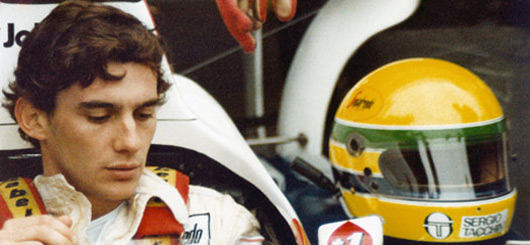
Depicting the kind of true-life drama that fiction can never quite live up to, Asif Kapadia’s Senna tells the story of famed Brazilian auto racer Ayrton Senna, who won three Formula One championships by the age of 31 and tragically died at 34 when he crashed during the 1994 San Marino Grand Prix. Covering his years as a F1 driver, his rivalry with teammate Alain Prost, and his struggles against the highly politicized Fédération Internationale de l’Automobile (FIA), Kapadia’s documentary presents a thorough portrait of the man and his career, making his name known to those of us with only basic Formula One knowledge, but it does so impressively and artfully, avoiding the pitfalls of the form and becoming more than just a biographical document.
Paced like a thriller and constructed like a biopic, the film thankfully abstains from most common tropes of the documentary form; comprised entirely of archival footage, the film contains no overbearing narration, talking-head interviews, or animated interludes designed to guide and entertain the viewer. Instead, Kapadia lets the images do the talking – apart from the occasional off-screen commentary from a variety of Formula One experts and veterans – and relies on the strength of his editing and composition to tell the story. Of course, the play-by-play commentary that frequently accompanies the race footage helps (as well as a terrifically moody score by Antonio Pinto), but generally the film avoids the kind of straightforward storytelling or finger-wagging lecturing that so often plagues modern documentaries. Senna is a predominantly visual affair, and thus a breath of fresh air in this pandering cinematic age
Though its hands-off approach takes some getting used to (especially for us F1 newbies), the strength of the dramatic tale being told eventually overcomes the strangeness, and the film picks up speed as it goes along, becoming more and more compelling as Senna’s extraordinary story unravels. But Kapadia needs not alter his style or resort to crafty editing in order to make the film compelling. Major events in the driver’s career – such as the 1989 Japanese Grand Prix, where Senna was stripped of his title and suspended for a minor infraction – are granted dramatic importance because of their placement in the narrative, but these events were watershed moments for Senna anyway, and Kapadia does little to heighten their relevance. He merely pieces the picture together, and lets it play out.
Ultimately, though, the film is about Senna himself, and the archival footage is surprisingly adept at giving a full picture of the tragic figure. He is, at different points, humble, arrogant, quiet, outspoken, ecstatic, and uncertain, but, most of all, he is depicted as deeply determined and highly spiritual. Though the film would perhaps be better served by presenting a more conflicted portrait of Senna (and a less overtly evil one of Prost, who is given the villain role almost by default), it’s hard to fault Kapadia for wanting to depict his central subject in such a fashion. He is, after all, a mythic icon to many, and the film succeeds in capturing this and presenting it in a restrained and effective manner. For a documentary about an auto racer, it’s exceedingly grand.

